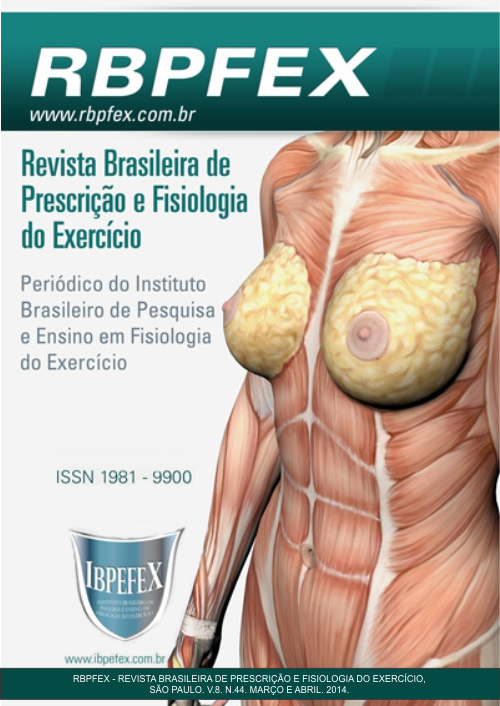Rating perceived exertion as tool in monitoring of intensity of effort in indoor cycling classes
Abstract
The Indoor Cycling (IC) is one of the most widely practiced today ingyms in Brazil and in the world.The IC is practiced on a stationary bike designed specifically for this type of class combining basic movements of traditional cycling combined with different musical rhythms. The IC is a predominantly aerobic exercise performed at high intensities, thus tools for monitoring these intensities by practitioners that is easy to use and low cost is needed. Therefore, the aimsof this study are to examine the response of HR and RPE during classes IC and the relation between the two variables. The sample was composed of 10 women practitioners of IC mean age of 37.5 ± 9.4 years. Were monitored two classes of IC of each volunteer in training real conditions, measuring HR and RPE during the classes. The results indicate that the IC monitored classes are held in highintensity, on average 90.3 ± 4.3% HR max and 5.2 ± 0.9 for RPE. Also found high and significant correlation (r = 0.79, p = 0.02) between HR and RPE. In this way, given the results presented we conclude that the IC classes are held in high intensity, requiring great work cardiorespiratory system. In addition, high and significant correlation between HR and RPE indicates that this is a valid tool for monitoring the intensity of IC classes.
References
-American College of Sports Medicine. Position Stand. The recommended quantity and quality of exercise for developing and maintaining cardiorespiratory and muscular fitness, and flexibility in healthy adults. Medicine and Science in Sports and Exercise. Vol. 30. Num. 6. 1998. p. 975-991.
-Battista, R.A.; Foster, C.; Andrew, J.; Wright, G.; Lucia, A.; Porcari, J.P. Physiologic responses during indoor cycling. Journal of Strength and Conditioning Research. Vol. 22. Num. 4. 2008. p. 1236-1241.
-Bianco, A.; Bellafiore, M.; Battaglia, G.; Paoli, A.; Caramazza, G.; Farina, F.; Palma, A. The effects of indoor cycling training in sedentary overweight women. Journal of Sports Medicine and Physical Fitness. Vol. 50. Num. 2. 2010. p. 159-165.
-Borg, G. V. Perceived exertion and pain scales. Champaign :Human Kinetics, 1998.
-Borg, G. V. Escalas de Borg para a Dor e o Esforço Percebido. São Paulo: Manole, 2000.
-Caria, M. A.; Tangianu, A.; Cancu, A.; Crisafulli, A.; Mameli, O. Quantification of Spinning® bike performance during a standard 50-minutes class. Journal of Sports Sciences. Vol. 25. Num. 4. 2007. p. 421-429.
-Ferrari, H. G. Comparação da intensidade de esforço entre dois diferentes programas de ciclismo indoor: Spinning e RPM. Anais: 3º Congresso Científico Latino-Americano de Educação Física. Piracicaba: Unimep. 2004. p. 67-71.
-Ferrari, H. G.; Guglielmo, L. G. A. Resposta da freqüência cardíaca e lactato sanguíneo durante aulas do programa RPM em mulheres. Revista de Educação Física do Exército. Vol. 137. 2007. p. 10-17.
-Grossl, T.; Guglielmo, L.G.A.; Silva, J.S.; Vieira, G. Respostas cardiorrespiratórias e metabólicas na aula de ciclismo indoor. Motriz. Vol. 15. Num. 2. 2009. p. 330-339.
-Kang, J., Chaloupka, E.C.; Mastrangelo, M.A.; Donnelly, M.S.; Martz, W.P.; Robertson, R.J. Regulating exercise intensity using ratings of perceived exertion during arm and leg ergometry. European Journal of Applied Physiology. Vol. 78. Num. 3. 1998. p. 241-246.
-López‐Minãrro, P.A.; Muyor-Rodriguez, J.M. Heart rate and overall ratings of perceived exertion during Spinning® cycle indoor session in novice adults. Science Sports. Vol. 25. 2010. p. 238-244.
-Machado, J.R.M.; Nascimento, A.M.; Santos, J.F.B.; Afonso, L.S.; Cal Abad, C.C. Percepção subjetiva de esforço como controle de carga em aulas de ciclismo indoor. Brazilian Journal of Sports and Exercise Research. Vol. 1. Num. 1. 2010. p. 42-47.
-Ribeiro, L. T.; Nascimento, J. D.; Liberali, R. Comparação da alteração da composição corporal de mulheres de 18 a 32 anos praticantes de ciclismo indoor e atividades no mini trampolim. Revista Brasileira de Prescrição e Fisiologia do Exercício. Vol. 2. Num. 7. 2008. p. 81-89. Disponível em: <http://www.rbpfex.com.br/index.php/rbpfex/article/view/68/67>
-Smith, K. I.; Drees, K.; Kamm, A.; Martin, J.; Steinke, S., York, J.; e colaboradores. Physiologic outcomes of a ten week “Spin” cycle intervention. Medicine and Science in Sports and Exercise. Vol. 32. Num. 5. 2000. S311.
-Shigematsu, R.; Ueno, L. M.; Nho, M. N. H.; Tanaka, K. Rate of Perceived Exertion as a Tool to Monitor Cycling Exercise Intensity in Older Adults. Journal of Aging and Physical Activity. Vol. 11. Num 1. 2004. p. 3-9.
-Valle, P. S.; Mello, D. B.; Fortes, M. S. R.; Dantas, E. H. M. Efeito da Dieta e do Ciclismo Indoor Sobre a Composição Corporal e Nível Sérico Lipídico. Arquivos Brasileiros de Cardiologia. Vol. 95. Num. 2. 2010. p. 173-178.
-Valle, V. S. Efeito de doze semanas de treinamento de ciclismo indoor sobre a composição corporal e nível sérico lipídico de mulheres adultas com sobrepeso. Revista Brasileira de Ciência e Movimento. Vol. 20. Num. 1. 2012. p. 34-40.
Authors who publish in this journal agree to the following terms:
- Authors retain the copyright and grant the journal the right of first publication, with work simultaneously licensed under the Creative Commons Attribution License BY-NC which allows the sharing of the work with acknowledgment of the authorship of the work and initial publication in this journal.
- Authors are authorized to enter into additional contracts separately for non-exclusive distribution of the version of the work published in this journal (eg, publishing in institutional repository or book chapter), with acknowledgment of authorship and initial publication in this journal.
- Authors are allowed and encouraged to post and distribute their work online (eg, in institutional repositories or on their personal page) at any point before or during the editorial process, as this can bring about productive change as well as increase impact and impact. citation of published work (See The Effect of Free Access).






